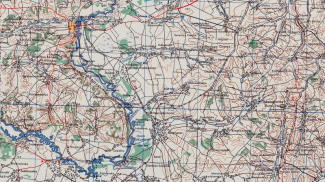Ukraine prepares to strike Korenevo and Russia has its sights on Pokrovsk. Day 915 of war

![]()
The Ukrainians in the Kursk region have captured the area between Gordeevka and Snagost east of the road linking the two and have thus secured a base to strike Korenevo from the south. Fighting continues to the east of this town, where both sides have made slight advances, pushing each other out of neighbouring villages. Ukrainian forces have also widened breakouts to the east (south, east and northeast of Sudzha), but without affecting the overall situation. The Russians became active on the border of the Sudzha and Belov districts, where they recaptured some villages and pushed the enemy back towards the border. Despite the change in captured terrain, fighting is continuing in an area whose extent was defined in the first week of the operation, and is showing more and more signs of stabilisation, which is also reflected in a decrease in the intensity of operations.
On 27 August, Ukrainian forces attempted to make an incursion into Russian territory in the Belgorod region. Unlike the actions accompanying the incursion into the Kursk region, designed to disperse Russian defences, the attack took place in the area of Nekhoteevka and, according to some reports, Shebekino, directly on the flanks of the enemy formations north of Kharkiv. There is conflicting information regarding the numbers of Ukrainian forces. According to Russian social media, the enemy was said to have engaged up to 500 troops in both areas. There are also reports of a traditional sabotage and reconnaissance groups, using smaller forces. The credibility of reports of a Ukrainian action near Shebekino (north of Vovchansk, where both sides of the border are under Russian control) is also uncertain, but the infiltration of Ukrainian saboteurs there cannot be ruled out.
The Russians are widening the starting base for their attack on Pokrovsk, Myrnohrad and Selydove, while at the same time threatening the Ukrainian defence at Karlivka from the west. Within a week of fighting, they seized at least half of Novohrodivka, a town with a pre-war population of 14,000 (Marinka, which was defended for two years, had a population of 9,000), the last urbanised area before the Pokrovsk and Myrnohrad. The seizure of Novohrodivka also opens up the possibility of striking Selydove from the north (battles are being fought over the two towns bordering this city from the east). At the same time, Russian troops began fighting for Mykolaivka, allowing them to move closer to neighbouring Myrnohrad. According to some sources, Russian troops have seized Kalynove north of the M04 highway (from Donetsk to Dnipro), threatening to cut off the Karlivka grouping and Ukrainian forces on the northern outskirts of Krasnohorivka.
The flanking of Vuhledar is deepening. Already several sections of the route from Marinka, which until recently was the main bypass behind the front line and the main supply route for the defenders south-west of Donetsk, are under Russian control, preventing its use by the Ukrainians. A relatively safe supply route for Vuhledar remains the local route to Bohoyavlenka, which is probably at least partly a dirt road. Russian troops entered the built-up area of Toretsk from the south and north-east. After seizing more hills in the Klishchiivka area, they pushed the defenders towards the Donetsk-Donbas canal south-east of Bakhmut. The invaders also crossed the canal at another location north of Chasiv Yar and advanced deep into the city centre.
![]()
On 26 August, the Russians carried out their largest ever attack on Ukraine’s energy infrastructure (for more details, see ‘Large-scale Russian strike on Ukraine’s energy infrastructure‘). Around 30 facilities in 15 regions were hit, including Kyiv’s Vyshhorod Hydroelectric Power Plant (north of the capital). Emergency power cuts were imposed throughout the country, and water supplies were disrupted in Kyiv and several regional cities. According to the Ukrainian Air Force Command (UAF), Russia allegedly used 127 rockets and 109 kamikaze drones, of which the defenders shot down 102 and 99 respectively.
On the night of 27 August, there was another large-scale attack, the main targets of which were probably military facilities. The UAF reported enemy use of ten missiles (including hypersonic Kinzhals) and 81 drones. Ukrainian air defence is thought to have shot down five cruise missiles and 60 ‘shaheds’. According to Belarusian sources, six drones were have flown into Belarus.
In the run-up to the massed attacks, Russia continued to make pinpoint strikes against targets deep inside Ukraine and to Ukraine’s immediate rear. Rockets and drones mainly struck Kharkiv (21, 22, 24 and 25 August) and Sumy (23 and 24 August) regions. On 21 August, a power substation in the Mykolaiv region was targeted, two days later an airfield near Myrhorod in the Poltava region was struck, and on 24 August – for the first time in several months – Snake Island. On 25 August, a Russian rocket hit a hotel in Kramatorsk occupied by foreigners. Among those killed was a Reuters Agency correspondent, a former British Army soldier. A total of 38 rockets and 104 suicide drones were allegedly used by the invaders between 21 and 25 August. Ukraine reported shooting down three missiles and 74 drones.
On 20 August, Commander-in-Chief of the Ukrainian Armed Forces General Oleksandr Syrskyi presented data on Russia’s use of means of destruction, including a detailed aggregate list of missiles and suicide drones used since February 2022, along with the number of downings. The information presented shows that the Ukrainian command is verifying earlier reports, mainly UAF communiqués published after missile attacks. The effectiveness of air defence in Syrsky’s aggregate presentation is much lower: for cruise missiles it is 56% and for ballistic missiles it is only 4%. Paradoxically, a relatively high level of 25% is achieved for the loss-rate’ of hypersonic missiles. In turn, the percentage of neutralized “shaheds” resulting from the comparison is 66%.. In total, during nearly two and a half years of the full-scale war, the Russians are said to have used 9,627 missiles of all types, of which the defenders brought down 2,429, with 25% efficiency. In the case of strike drones of all types, of the 13,997 used, 9,272 (66%) were claimed as destroyed. Note that these statistics covers the entire period of operations, including before the handover of Western air defence systems to Ukraine. Current effectiveness rates are likely to be higher than those presented.
With regard to cruise missiles, Syrskyi’s information is close to the estimate presented earlier by Estonian Army Commander General Martin Herem. In an interview with the Financial Times on 31 May, he estimated the effectiveness of Ukraine’s air defence against cruise missiles at ‘at best 50%’. In doing so, he pointed out that this was possible due to the Patriot systems, and that prior to their acquisition, the Ukrainians managed to knock down 7% of missiles in this category. In the communications of the UAF, the percentage of cruise missiles shot down rarely falls below 80%. This is a relatively constant value. Similar effectiveness was demonstrated even before receiving Western air defence systems.
![]()
In a Ukrainian drone attack on Marynovka airfield in the Volgograd region on 22 August, three hangars were destroyed and storage facilities damaged. The large scale of the damage to the newly built hangars indicates that they were housing ammunition. A day later, a ferry carrying fuel tankers (the Ukrainians were to use Neptune missiles) was destroyed in the port of Kavkaz in Krasnodar Krai (the Ukrainians are thought to have used Neptune missiles), and an ammunition depot near Ostrogozhsk in Voronezh region was destroyed on 24 August.
However, attacks on the Moscow region and Millerovo airfield in the Rostov region (21 August) and Saratov and the Engels airfield (where the Russian strategic aviation base is located) in the Saratov region (26 August) were unsuccessful. The Rosreserva fuel depot in Proletarsk in the Rostov region, hit by Ukrainian drones on 18 August, continues to burn. This was contributed to by another attack, on 23 August.
On 27 August, General Syrskyi summarised the results of the Kursk region operation: Ukraine controls more than 100 villages, 1,294 km2 of territory and has taken 594 Russian soldiers prisoner. President Volodymyr Zelensky, in turn, reported on 23 August that the aim of the operation was “first and foremost to replenish the exchange fund”, i.e. to capture Russian soldiers who could be handed over to the Russian Federation in exchange for Ukrainian prisoners. The second objective, is to stop the Russian offensive in the Sumy region.
On 20 August, the acting governor of the Kursk region of the Russian Federation, Alexei Smirnov, notified that the early elections for the region’s governor scheduled for 6–9 September would start earlier – on 29 August. The decision to accelerate and extend the voting was taken “in order to guarantee the safety, protection of life and health of Russian citizens”. Furthermore, the Russian Central Election Commission cancelled elections in eight Russian regions of the region near the border with Ukraine and in the city of Levov for security reasons. According to Smirnov, 133,000 residents have so far been evacuated from the border areas, while around 19,000 remain.
![]()
On 24 August, the Pentagon announced another military support package. Like the previous one (dated 9 August), it is worth $125 million and includes similar equipment. Under the Presidential Drawdown Authority (PDA) mechanism, HIMARS guided missiles, 105 mm and 155 mm calibre artillery ammunition, Javelin and TOW anti-tank guided missiles, AT-4 anti-tank grenade launchers, and drone combat equipment and ammunition (c-UAS), among others, will be transferred from US Army stores.
On 23 August, the Norwegian government agreed to transfer technology for the production of 155 mm calibre ammunition from the Norwegian company Nammo to Kyiv. The Norwegians will also cover the costs of producing the ammunition in Ukraine. It has not been disclosed when this project will start.
On 26 August, Czech Prime Minister Petr Fiala announced that Kyiv was receiving tens of thousands of artillery shells per month. He claimed that Ukraine received two million artillery shells and 22 million small arms cartridges under an ammunition programme coordinated by Prague and directly from the Czech Republic since February 2022.
![]()
On 24 August, thanks to the mediation of the United Arab Emirates, an exchange of prisoners of war took place between Russia and Ukraine – 115 soldiers each from both sides. Among others, 82 Mariupol defenders who had been in captivity for more than two years returned to their country. Russia, in turn, recovered soldiers captured during operations in the Kursk region.
On 26 August, President Zelensky pledged to present a plan to counter the problem of collaboration and illegal border crossing within two weeks. The announcement was made in the wake of the publicity generated by the flight from the country of a deputy of the Verkhovna Rada of Ukraine, Artem Dmytruk (a former member of the pro-presidential party Servant of the Nation), accused of pro-Russian activities.
![]()
On 25 August, the Ukrainian Foreign Ministry reported that, under the pretext of exercises, the armed forces of Belarus had dislocated a significant number of personnel and military equipment (including special operations forces and Wagner Group mercenaries) on the border with Ukraine. The document warned Minsk against committing “tragic mistakes for their country under Moscow’s pressure” and called for the troops to be moved out. It announced that, in the event of a border breach, Kyiv would “take all necessary measures to exercise the right to self-defence”.
The statement was preceded by a media statement by Alyaksandr Valfovich, Secretary of the State Security Council of Belarus, who stated that currently a group of Ukrainian troops in the north of the country numbered around 120,000 soldiers, while the Ukrainian army was conducting intelligence activities near the Belarusian border. In a state TV reported that this was the reason Minsk was strengthening its military presence on the border, redeploying tanks, aviation and Polonez missile systems there, among other equipment.
Despite the harsh tone of the Ukrainian Foreign Ministry’s communiqué, the spokesman for the State Border Service of Ukraine, Andriy Demchenko, did not confirm the ministry’s reports, but stated on 26 August that no Belarusian troop overflow had been observed and that the situation in the area ‘remains unchanged and monitored’. On the same day, a Ukrainian Foreign Ministry document was referred to by a spokesman for Belarusian diplomacy, who speculated that the statement was part of Kyiv’s ‘devious game planned for internal use or to gain applause in the West’.






